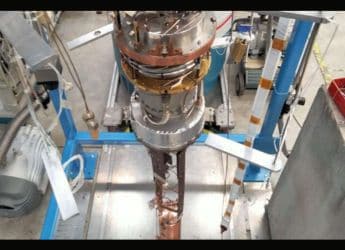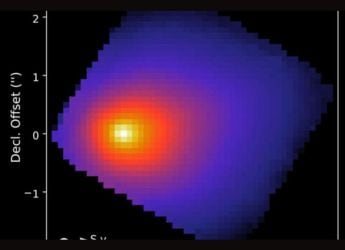- Home
- Science
- Science News
- James Webb Space Telescope Has Deployed All Hexagonal Mirror Segments, NASA Says
James Webb Space Telescope Has Deployed All Hexagonal Mirror Segments, NASA Says
The primary mirror of James Webb telescope comprises 18 hexagonal segments of gold-plated beryllium.

Photo Credit: NASA
James Webb Space Telescope has unfolded and attained its final shape in space
NASA said it has completed deploying all the hexagonal mirror segments of its James Webb Space Telescope. The delicate operation to move the $10-billion (roughly Rs. 74,500 crore) space observatory's individual mirror segments out of their launch positions took nearly a week, during which the motors made over a million revolutions. The space agency said engineers sent commands to tiny motors, called actuators, to slowly move each segment about half the length of a paper clip so that each of them is positioned in a way that they have enough space for mirror alignment. Engineers have begun a month-long process to bring the telescope into focus.
The primary mirror of the James Webb telescope comprises 18 hexagonal segments of gold-plated beryllium metal. When all segments are aligned, the mirror measures 21 feet and four inches in diameter. The primary mirror is much larger when compared to the Hubble Space Telescope, which was launched 30 years ago. The more powerful James Webb is set to replace the Hubble soon after its deployment processes are complete.
Our mirror segment deployments are complete! ????
— NASA Webb Telescope (@NASAWebb) January 19, 2022
Using motors, each segment was moved out about half the length of a paper clip to clear the mirrors from their launch restraints and give each segment enough space for mirror alignment. https://t.co/XWbVLQuch1 #UnfoldTheUniverse pic.twitter.com/d121DHldiX
“The mirror deployment team incrementally moved all 132 actuators located on the back of the primary mirror segments and secondary mirror. The primary mirror segments were driven 12.5mm away from the telescope structure,” said Erin Wolf, Webb program manager at Ball Aerospace, the Colorado-based company which designed and built the telescope's advanced optical technology and lightweight mirror system, in a blog post.
???? ???? You say you want a revolution? How about over a million? #NASAWebb's mirror motors made over a million revolutions this week as we moved all 132 actuators on the backs of the primary mirror segments and the secondary mirror! #UnfoldTheUniverse
— NASA Webb Telescope (@NASAWebb) January 19, 2022
To get a better understanding of how these motors, or actuators, work, NASA previously shared a GIF, explaining the function.
???? ???? You say you want a revolution? How about over a million? #NASAWebb's mirror motors made over a million revolutions this week as we moved all 132 actuators on the backs of the primary mirror segments and the secondary mirror! #UnfoldTheUniverse
— NASA Webb Telescope (@NASAWebb) January 19, 2022
NASA also shared a “fun fact” on Twitter. It said the beryllium metal used in the 18 hexagonal segments of the primary mirror is six times stronger than steel. “But even against beryllium's strength, the motors can actually individually shape the curvature of each mirror segment,” it added.
Fun fact: Our mirrors are made of beryllium, which is 6 times stronger than steel. ???? ????♀️
— NASA Webb Telescope (@NASAWebb) January 19, 2022
But even against beryllium's strength, the motors can actually individually shape the curvature of each mirror segment! #UnfoldTheUniverse
The 18 segments had been folded together to fit inside an Ariane 5 rocket that carried the telescope to space after the launch on December 25. The telescope is an international collaboration between NASA, European Space Agency, and Canadian Space Agency.
Catch the latest from the Consumer Electronics Show on Gadgets 360, at our CES 2026 hub.
Related Stories
- Samsung Galaxy Unpacked 2025
- ChatGPT
- Redmi Note 14 Pro+
- iPhone 16
- Apple Vision Pro
- Oneplus 12
- OnePlus Nord CE 3 Lite 5G
- iPhone 13
- Xiaomi 14 Pro
- Oppo Find N3
- Tecno Spark Go (2023)
- Realme V30
- Best Phones Under 25000
- Samsung Galaxy S24 Series
- Cryptocurrency
- iQoo 12
- Samsung Galaxy S24 Ultra
- Giottus
- Samsung Galaxy Z Flip 5
- Apple 'Scary Fast'
- Housefull 5
- GoPro Hero 12 Black Review
- Invincible Season 2
- JioGlass
- HD Ready TV
- Laptop Under 50000
- Smartwatch Under 10000
- Latest Mobile Phones
- Compare Phones
- OPPO Reno 15 Pro Max
- Honor Win RT
- Honor Win
- Xiaomi 17 Ultra Leica Edition
- Xiaomi 17 Ultra
- Huawei Nova 15
- Huawei Nova 15 Pro
- Huawei Nova 15 Ultra
- Asus ProArt P16
- MacBook Pro 14-inch (M5, 2025)
- OPPO Pad Air 5
- Huawei MatePad 11.5 (2026)
- Xiaomi Watch 5
- Huawei Watch 10th Anniversary Edition
- Acerpure Nitro Z Series 100-inch QLED TV
- Samsung 43 Inch LED Ultra HD (4K) Smart TV (UA43UE81AFULXL)
- Asus ROG Ally
- Nintendo Switch Lite
- Haier 1.6 Ton 5 Star Inverter Split AC (HSU19G-MZAID5BN-INV)
- Haier 1.6 Ton 5 Star Inverter Split AC (HSU19G-MZAIM5BN-INV)

















